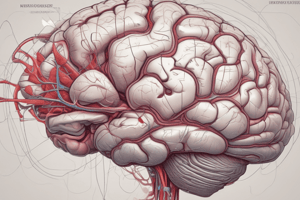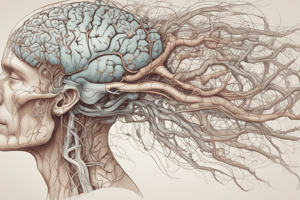Podcast
Questions and Answers
Which of the following is the MOST accurate description of how neurological conditions generally manifest?
Which of the following is the MOST accurate description of how neurological conditions generally manifest?
- Primarily affecting sensory perception, causing blindness or deafness.
- Affecting the brain, spinal cord, and nerves, leading to symptoms related to movement, cognition, sensation, or autonomic function. (correct)
- Affecting only motor functions, leading to paralysis.
- Exclusively impacting cognitive abilities, such as memory loss.
Traumatic Brain Injury (TBI) is primarily treated with antibiotics to prevent infection in the damaged brain tissue.
Traumatic Brain Injury (TBI) is primarily treated with antibiotics to prevent infection in the damaged brain tissue.
False (B)
For spinal conditions like herniated discs and spinal stenosis, which of the following treatments is LEAST likely to be used?
For spinal conditions like herniated discs and spinal stenosis, which of the following treatments is LEAST likely to be used?
- Muscle relaxants to reduce spasms
- Antiviral medications to target nerve inflammation (correct)
- NSAIDs and acetaminophen for pain management
- Opioids for severe pain
Spinal Muscular Atrophy (SMA) is caused by a genetic mutation in the __________ gene.
Spinal Muscular Atrophy (SMA) is caused by a genetic mutation in the __________ gene.
Which of the following is NOT a recognized type of cerebral palsy (CP)?
Which of the following is NOT a recognized type of cerebral palsy (CP)?
Multiple Sclerosis (MS) is primarily treated with medications that cure the demyelination of nerve fibers in the central nervous system.
Multiple Sclerosis (MS) is primarily treated with medications that cure the demyelination of nerve fibers in the central nervous system.
Motor Neuron Disease (MND) encompasses several subtypes, including Amyotrophic Lateral Sclerosis (ALS), Primary Lateral Sclerosis (PLS), Progressive Muscular Atrophy (PMA), and Progressive __________.
Motor Neuron Disease (MND) encompasses several subtypes, including Amyotrophic Lateral Sclerosis (ALS), Primary Lateral Sclerosis (PLS), Progressive Muscular Atrophy (PMA), and Progressive __________.
Which of the following is NOT typically used as a primary treatment for epilepsy?
Which of the following is NOT typically used as a primary treatment for epilepsy?
Parkinson's Disease (PD) is primarily caused by the degeneration of __________ neurons in the brain.
Parkinson's Disease (PD) is primarily caused by the degeneration of __________ neurons in the brain.
Deep brain stimulation (DBS) for Parkinson's Disease (PD) directly regenerates damaged dopaminergic neurons.
Deep brain stimulation (DBS) for Parkinson's Disease (PD) directly regenerates damaged dopaminergic neurons.
Which cognitive function is LEAST likely to be affected in patients with Dementia?
Which cognitive function is LEAST likely to be affected in patients with Dementia?
In the acute management of TBI, __________ agents are used to reduce brain swelling.
In the acute management of TBI, __________ agents are used to reduce brain swelling.
Match each neurological condition with its corresponding primary characteristic or cause:
Match each neurological condition with its corresponding primary characteristic or cause:
Cholinesterase inhibitors, used for dementia, directly reverse the underlying brain cell damage.
Cholinesterase inhibitors, used for dementia, directly reverse the underlying brain cell damage.
Which diagnostic method is MOST specific for identifying seizure activity in epilepsy?
Which diagnostic method is MOST specific for identifying seizure activity in epilepsy?
In Multiple Sclerosis (MS), demyelination occurs in the
In Multiple Sclerosis (MS), demyelination occurs in the
The Australian Burden of Disease Study 2024 reported that neurological conditions account for less than 5% of the total burden of disease in Australia.
The Australian Burden of Disease Study 2024 reported that neurological conditions account for less than 5% of the total burden of disease in Australia.
Regarding Traumatic Brain Injury (TBI), which of the following acute treatments is MOST aimed at preventing secondary brain damage rather than directly repairing the initial injury?
Regarding Traumatic Brain Injury (TBI), which of the following acute treatments is MOST aimed at preventing secondary brain damage rather than directly repairing the initial injury?
A key characteristic symptom unique to Motor Neurone Disease (MND) which involves visible twitching of skeletal muscle is called ___________.
A key characteristic symptom unique to Motor Neurone Disease (MND) which involves visible twitching of skeletal muscle is called ___________.
Match the therapy with the neurological condition it PRIMARILY addresses.
Match the therapy with the neurological condition it PRIMARILY addresses.
Flashcards
TBI
TBI
Dysfunction of the brain caused by an external force.
Spinal Conditions
Spinal Conditions
Conditions impacting the spine, causing pain and mobility issues.
SMA
SMA
A genetic disorder affecting motor neurons, leading to muscle weakness.
Cerebral Palsy
Cerebral Palsy
Signup and view all the flashcards
MS
MS
Signup and view all the flashcards
MND
MND
Signup and view all the flashcards
Epilepsy
Epilepsy
Signup and view all the flashcards
Parkinson's Disease
Parkinson's Disease
Signup and view all the flashcards
Dementia
Dementia
Signup and view all the flashcards
Neurological Categories
Neurological Categories
Signup and view all the flashcards
Study Notes
Neurological Conditions Overview
- Neurological conditions impact multiple systems
- Affects the brain, spinal cord, and nerves
Categories of Neurological Conditions
- Neurodegenerative diseases affect neurons
- Neuromuscular disorders affect muscles
- Brain conditions have a variety of causes
- Spine conditions impact the entire body
Neurological Conditions in Australia - 2024 Data
- 8.4% of the Australian burden of disease is attributed to neurological conditions
- It is more prevalent in women (10%) than men (6.8%)
- Common diseases affecting Australians include:
- Dementia (4.5%)
- Other neurological conditions (0.9%)
- Migraine and Epilepsy (0.8% each)
- Parkinson's disease (0.8%)
- Motor neurone disease and Multiple sclerosis (0.3% each)
Traumatic Brain Injury (TBI)
- TBI involves brain dysfunction due to an external force
- The injuries are often from falls, car accidents, sports injuries, or assaults
- Classification based on injury type:
- Penetrating vs non-penetrating
- Concussions and contusions are common
- Brain haemorrhages and intracranial haematomas can occur
- Coup-countercoup injury and diffuse axonal injury are possible
- Second impact syndrome is a risk
- Severity is classified as mild, moderate, or severe using the Glasgow Coma Scale (GCS)
Spinal Conditions
- Spinal conditions impact the spine, entire body, causing pain, discomfort, and mobility issues
- Examples include herniated disc, spinal stenosis, scoliosis, and cervical spondylosis
- Spinal cord injuries can also occur
Spinal Muscular Atrophy (SMA)
- SMA is a genetic disorder affecting motor neurons in the spinal cord
- Leads to muscle weakness and atrophy
- Caused by a defect in the SMN1 gene
- SMA has four different types
- Primarily affects muscles close to the body
- There is no cure, but treatments can slow disease progression
Cerebral Palsy (CP)
- CP is a group of neurological disorders affecting movement, coordination, and muscle tone
- Results from brain damage occurring before, during, or shortly after birth
- Types of CP include spastic, dyskinetic, and ataxic
- Causes include prenatal, perinatal, and postnatal factors
- There is no cure
- Management includes medications for muscle stiffness and seizures
- Treatments addresses drooling and involuntary movements
- Measures provide easing discomfort
Multiple Sclerosis (MS)
- MS is a chronic autoimmune disorder affecting the central nervous system (CNS)
- The immune system attacks the myelin sheath, disrupting nerve signals
- Several forms of MS exist:
- Relapsing-remitting (RRMS)
- Secondary progressive (SPMS)
- Primary progressive (PPMS)
- Progressive-relapsing (PRMS)
- Treatments include disease-modifying therapies, symptomatic therapies, and emerging therapies
Motor Neurone Disease (MND)
- MND is a group of progressive neurological disorders
- Affects motor neurons, impacting voluntary muscle movements
- Types of MND include amyotrophic lateral sclerosis, primary lateral sclerosis
- Other types are progressive bulbar palsy and progressive muscular atrophy
- Symptoms include muscle weakness, stiffness, difficulty speaking and swallowing
- Fasciculations and loss of coordination/balance are possible
- Treatments include disease-modifying strategies, symptom management and emerging therapies
Epilepsy
- Epilepsy is a neurological condition with recurrent, unprovoked seizures
- It's diagnosed after two or more unprovoked seizures
- Seizures can be focal or generalized
- Diagnosis involves neurological exam, EEG, imaging, and blood tests
- Treatment involves anti-seizure medications
Parkinson's Disease (PD)
- PD is a progressive disorder affecting movement
- Caused by degeneration of dopaminergic neurons in the brain
- Symptoms include:
- Tremor, bradykinesia, and muscle rigidity
- Postural instability
- Treatment strategies:
- Dopamine agonists
- MAO-B and COMT inhibitors
- Deep brain stimulation (DBS)
Dementia
- Dementia is a group of symptoms affecting memory, thinking, and social abilities
- Characterized by a significant decline in cognitive function
- Caused by brain cell damage and communication issues
- Key Dementia pathophysiology:
- Alzheimer’s, vascular, and Lewy body dementia
- Frontotemporal dementia
- Treatment and therapies:
- Cholinesterase inhibitors and antidepressants
- Anxiolytics and antipsychotics
- Reminiscence and cognitive stimulation therapy
- Lifestyle changes
Lecture Recap
- Neurological conditions impact the brain, spinal cord, and nerves
- Causes symptoms related to movement, cognition, sensation, or autonomic function
- Acute Traumatic Brain Injury (TBI) is managed with antifibrinolytics, antiepileptics, hyperosmolar agents, and sedatives
- Chronic TBI treatment includes antidepressants, psychostimulants, and anticonvulsants
- Emerging TBI therapies focus on neuroprotection and inflammation reduction
- Spinal conditions are treated with NSAIDs, acetaminophen, opioids, muscle relaxants, corticosteroids, analgesics, physiotherapy and support
- Spinal Muscular Atrophy (SMA) is treated with disease-modifying medications
- Respiratory and nutritional care is also used
- Cerebral Palsy (CP) is treated to manage muscle relaxants, anticonvulsants, therapies, and interventions
- Multiple Sclerosis (MS) is treated with disease-modifying therapies and symptomatic management
- Motor Neurone Disease (MND) treatment involves symptom management, and emerging gene-based therapies
- Epilepsy is treated with anti-seizure medications
- Parkinson's Disease (PD) treatment includes levodopa, dopamine agonists, MAO-B and COMT inhibitors, and deep brain stimulation
- Dementia is managed using cholinesterase inhibitors, memantine, antidepressants, antipsychotics, and supportive therapies
Studying That Suits You
Use AI to generate personalized quizzes and flashcards to suit your learning preferences.




